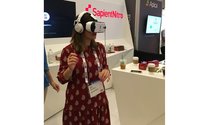Commentary
The Agency-Brand Paths For Augmented And Virtual Reality
- by Chuck Martin , Staff Writer, August 18, 2016
 Virtual reality and augmented reality may be traveling in the same basic direction but for agencies and brands, they’re on different roads.
Virtual reality and augmented reality may be traveling in the same basic direction but for agencies and brands, they’re on different roads.
The SapientNitro display at the annual eTail East conference in Boston was dominated by a show of virtual reality featuring a digital apartment where information on items shown could be displayed simply by looking at the object.
That particular display, also used at previous shows, was sort of an augmented reality experience inside a virtual reality headset.
These sorts of demonstrations at trade shows tend to attract lots of attention, especially from those who have not seen or experienced either of the realities.
Like other agencies, SapientNitro is involved with both augmented and virtual reality.
At the eTail East show this week, I sat down with Jon Panella, vice president of commerce strategy at SapientNitro, for some agency insights into where virtual reality and augmented reality fit.
“We’re playing in both spaces and we think there’s opportunity in both,” said Panella.
“Certainly from an AR perspective, we’re definitely seeing applicability, when you look at things like furniture, appliances and bedding. It provides the ability to work with a client around how you would look at multiple items on a table at the same time. A place setting, plus a tablecloth and the glasses to go with it. How would that look in your house? And bringing that to the home for people to be able to look at. A lot of times in-store you don’t get the same experience.
“VR is a little trickier. Right now it’s still in the infancy stage. Leading edge retailers are going to be looking at it. Certainly, in 2017.
One of the questions around augmented reality is the level of purchasing that may occur. Panella sees significant opportunity in the small to mid-product space, such as how a chair would look in a person’s living room. “Not an inexpensive item, but still a reasonably priced item,” said Panella.
“Clothing is a little trickier,” he said. “If you can’t get that exact fit of how it looks on a person, certainly people aren’t going to tend to buy off of that, so there’s still some growth in the technology.”
Brands that have their own set of products are pretty much leading the charge in AR, such as those that are kind of iconic in their space, such as those already having kiosks and strong mobile apps, said Panella.
“Things out there like Cartwheel at Target, which is a good example of how to engage the consumer for mobile. So they’re somebody who’s looking at ‘how do I take this a step further?’ How do I get them to use Cartwheel to do more than just coupons?”
The implication here is that the leaders in other areas such as mobile are likely to be the new leaders in worlds of augmented and virtual realities.
“It’s the top of the spear leading guys that tend to invest in those things now,” Panella said. “You also will see boutiques that have more of a luxury presence in the space that will take advantage of it also.”
When it comes to AR and VR, Panella said agencies have to experiment and be ready to fail.
“We tell our clients that all the time. But the second step of that is you have to be able to prove there’s some business value behind it.
“Too many people try to jump out with some of these technologies without really a justification just because it was cool. You should absolutely do that, but the next step is getting the right data to be able to drive that. It all comes back to the data state of the retail business.
“Retailers have a ton of data; they don’t know what to do with it. So if they can leverage it properly, you can come up with very justifiable pitch.”
For VR and AR, agencies and brands are not necessarily in the same place when it comes to taking the lead.
“In the case of AR, the agencies are absolutely driving that, because it’s a concept and because of the breadth of customers that the agency community has, it can be driven into very many spaces right now and justifiable,’ Panella said.
“VR will probably come a bit more from the brands, because the brands are going to have to come up with that unique value proposition that’s to them. For the next 18 to 24 months, anything done in VR is going to be very custom for a brand,” he said.
“AR will become very widespread and mass market.”
We’re very much on the same page on that.



